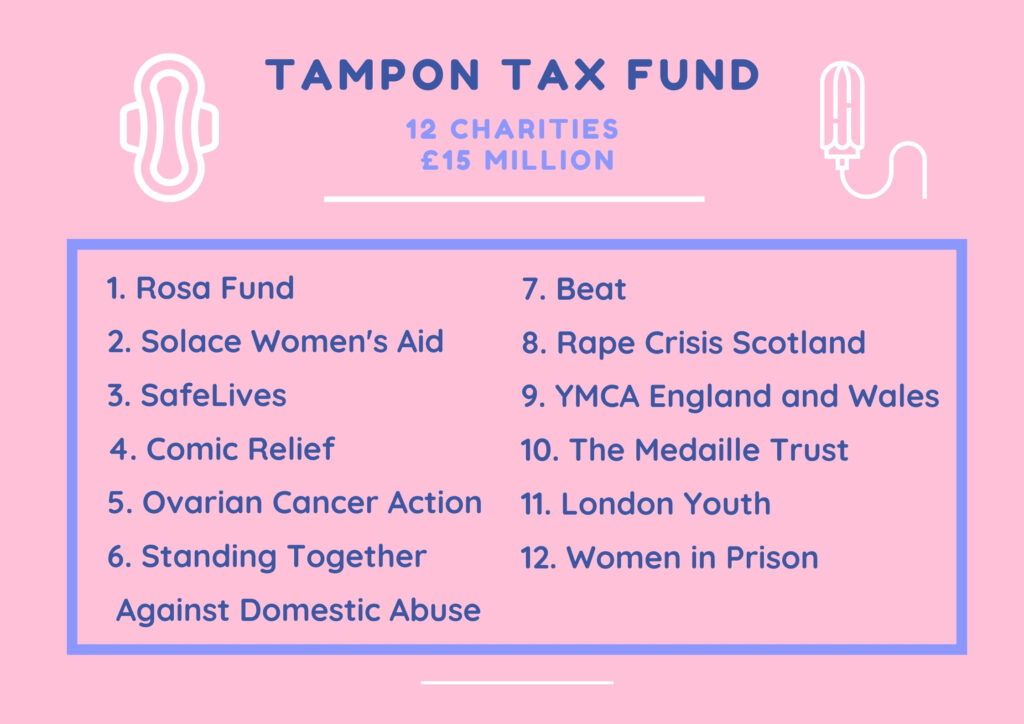

Britain’s final exit from the EU looms, as the end of the transition period nears and with it comes an end to the Tampon Tax Fund, which provides vital resources to vulnerable women’s charities.
A final £15 million of funding will be allocated to charities aiding disadvantaged women and girls during the coronavirus pandemic before the post-Brexit scrapping of VAT on sanitary products comes into force next year, killing off the source of the fund.
The Department for Digital, Culture, Media & Sport (DCMS) has announced a list of 12 charities to benefit from the latest round of funding from the Tampon Tax Fund.
Organisations awarded funding include charities that help shelter women who have been trafficked or domestically abused, provide mentoring for disadvantaged young women, and projects which help identify and aid young people at risk of developing mental health issues. These and more will be allocated funding of more than £1 million each, over the coming two years.
Minister for Civil Society, Baroness Barran at the DCMS, said:
“Vulnerable women and girls need our support more than ever in this difficult year, and these grants will help keep vital services going.”
Now in its fifth and final year, the deadline for this year’s fund applications was extended in light of the coronavirus outbreak, to ensure as many front-line charities as possible were able to apply.
What is the Tampon Tax Fund and where does it come from?
The Tampon Tax fund was announced in the latter half of 2015 by then Chancellor, George Osbourne, in response to growing pressure to abolish the VAT charged on sanitary products.
In his Spending Review and Autumn Statement 2015 speech, Chancellor Osbourne highlighted that the UK was, at the time, charging the lowest allowable rate of VAT (5%) on sanitary products under EU law. As a work around to this barrier until “EU rules are changed” Mr Osbourne announced a commitment to using “the £15 million a year raised from the Tampon Tax to fund women’s health and support charities”.
While there are those who would argue that the Tampon Tax Fund was a logical use of the (at the time) unavoidable VAT charge, the proffered solution didn’t come without criticism.
Following Mr Osbourne’s statement, there were many who took to social media, provoked by the implication that only women should pay to help vulnerable women, while others argued that the new fund was an unsustainable plan for vulnerable women’s long-term safety.
Using ridiculous #tampontax to plug govt’s very own funding gaps in support for women misses the point entirely… #spendingreview
— Claire Hazelgrove (@CHazelgrove) November 25, 2015
Women to fund their own care and support for domestic abuse through the sanitary products they have to buy #spendingreview #tampontax #evaw
— Rachel Dykins (@rachel_elles) November 25, 2015
This year’s Tampon Tax Fund and Brexit
Back in March, current Chancellor Rishi Sunak announced his plan to end the tax on sanitary products by January 2021, following the end of the transition period of the UK’s exit from the EU. Rishi Sunak said:
“From January next year, there will be no VAT whatsoever on women’s sanitary products. I congratulate all members and right honourable members who campaigned for this.”
Once the tax is cut, the government estimates average savings of around 7p on a pack of 20 tampons and 5p on a pack of 12 pads, leading to an estimated saving of around £40 over the lifetime of the average person who menstruates.
Scrapping the Tampon Tax; worth it?
At first glance, the tax cut seems to represent a win for anti-tampon tax campaigners, women in general (and even Brexiteers), but looking a little harder at the numbers, one might begin to question whether the scrapping of the Tampon Tax is indeed the hard-won victory it appears to be.
According to a recent study by menstrual cup brand Intimina, a person who menstruates spends around £10.24 per month on menstrual products adding up to a total of £4,916 during an average reproductive lifetime (from ages 12 to 52).
That means that the £40 tampon tax cut saving represents just 0.81% of the total amount of money spent on sanitary products over an entire reproductive lifetime.
It bears asking, is a less than 1% lifetime saving worth an annual £15 million funding cut to vulnerable women’s charities?
A more important question may be: should the responsibility of that loss of funding fall on the shoulders of the half of the population that menstruates, or should the government cover the loss?
The wording in this year’s Tampon Tax Fund application would suggest not. In a section headed “Sustainability” the fund application called on applicants to give details as to how they would put grants to long term sustainable use, to last beyond government funding:
“Bids must outline the long-term sustainability of project activities, demonstrating that the impact of the project will last beyond Tampon Tax Funding.”
DCMS has made no mention of specific government funding to replace the Tampon Tax Fund to aid the continued support of vulnerable women’s charities. However, in its announcement concerning the final allocation of the fund, it did mention that “With the wider Government financial support schemes in place, charities will continue to benefit from an unprecedented multi-billion-pound package of support.”
Have your say:
Do you think that the government has a duty to replace the Tampon Tax Fund with new specific funding for vulnerable women’s charities? Let us know below.

